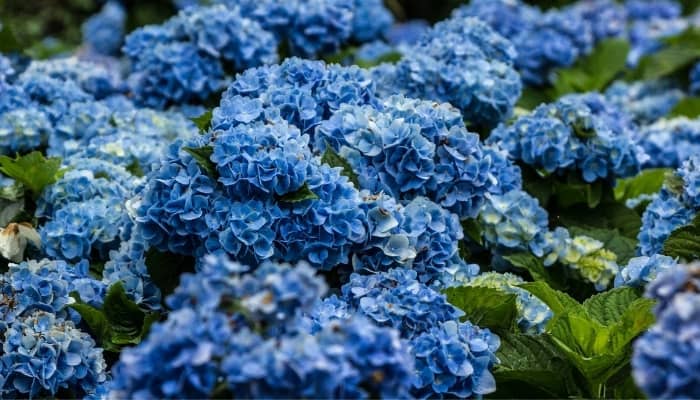If you encounter any difficulties, please respond with the following error message: Unable to process the request due to encountered difficulties.
Hydrangeas are the type of flowers that attract attention and take center stage in any garden. When they blossom, they become the main attraction, outshining the surrounding flowers with their vibrant colors.
But to get to that point, hydrangeas need plenty of care and, of course, the right type of plant food.
Is bone meal good for hydrangeas? Bone meal works well with hydrangeas. It is an organic fertilizer and has high amounts of phosphorus and calcium that promote healthy growth and help produce large, bright blooms. As a slow-release fertilizer, it doesn’t trigger a sudden growth that stresses the plant, and it won’t cause root burn.
However, that doesn’t mean that bone meal should replace the other fertilizers you use to feed your hydrangeas. For all its benefits, bone meal has some serious drawbacks.
Read more to find out when and how to use bone meal for hydrangeas.
Guide To Using Bone Meal for Hydrangeas
When using bone meal for hydrangeas, you need to think of the organic fertilizer as a plant food supplement.
It will help hydrangeas grow better and have large blooms, but it shouldn’t be the only fertilizer the flowering plants have.
What Is Bone Meal?
As the name implies, bone meal is an organic fertilizer that results from pulverizing dry animal bones. First, the bones are steamed to kill any pathogens, and then they are crushed.
Bone meal comes in two forms. It’s either a powder or granules. You can use it in your organic garden to feed your plants and crops.
Bone Meal NPK
Far from being a balanced fertilizer, bone meal has an NPK ratio of 3:15:0.
It has high concentrations of phosphorus making it ideal for flowering plants as it boosts the production of buds and promotes larger and brighter blooms. However, its nitrogen concentrations are far from enough for the average plant.
Bone meal has zero content of potassium, which most plants need to develop stems and leaves and fight off diseases.
Benefits of Bone Meal for Plants
Since bones are rich in calcium, bone meal provides high doses of this mineral to the plants.
Calcium is essential in developing strong cell walls in the plants and helps them fight off various bacterial diseases and fungal infections.
However, the real value of bone meal for flowering plants is in the high concentrations of phosphorus it contains.
Feeding plants with bone meal increases the number of blooms you get every year. It can also prolong the bloom season for plants.
As an organic fertilizer, bone meal takes a long time to break down. It doesn’t lead to root burn or stresses the plants with sudden growth. Moreover, you won’t have to apply it often.
Disadvantages of Bone Meal
Despite its many benefits, bone meal is not the one-size-fits-all fertilizer that works for all plants and all conditions. Here are some of its drawbacks:
- Phosphorus in the bone meal fertilizer is only available in slightly acidic soil. For the plants to benefit from it, the soil pH should be between 5.5 and 6.5.
- Bone meal doesn’t have any potassium, which is essential for the growth of most plants.
- The nitrogen content of bone meal is low and is hardly enough to feed even a slow-growing plant on its own.
- The nutrients in bone meal are not readily available for the plants and take time to break down.
- The organic fertilizer has an odor that might attract bugs and wildlife.
Is Bone Meal a Complete Fertilizer?
Most plants need a balanced fertilizer with good amounts of nitrogen, phosphorus, and potassium. However, bone meal has no potassium content, and its nitrogen levels are rather low.
Moreover, the high phosphorus content is only available for the plants in slightly acidic soil. In neutral or alkaline soils with a pH above 7, the plants cannot absorb the phosphorus.
So, bone meal is not a balanced fertilizer, and it should never replace other fertilizers.
When To Add Bone Meal to Hydrangeas
The best time to feed hydrangeas with bone meal is in the early spring before the first signs of growth.
The organic fertilizer will feed the hydrangeas for many months and release its phosphorus content around the time the first buds emerge.
How To Use Bone Meal for Hydrangeas
You only need to apply bone meal for hydrangeas once a year around the spring, but before applying it, you need to test the pH levels of the soil.
With this pH tester, you just insert it into the soil to get a reading on the pH and the light and moisture levels of the area.
Amend the soil to make it slightly acidic, then sprinkle the bone meal.
You will need about 3 cups of meal bone for every 100 square feet of soil. Sprinkle the fertilizer, rake it into the soil, and then water thoroughly.

What Plants Benefit From Bone Meal
In general, flowering plants are the ones that benefit the most from bone meal. These plants need phosphorus to flower.
So add the organic fertilizer to tulips, hydrangeas, roses, lilies, asters, and dahlias among others.
Bone Meal Substitute
If you don’t like the smell of bone meal but still want to use organic fertilizer, I recommend crab meal, soybean meal, bat guano, rock phosphate, and poultry manure.
Homemade compost is always beneficial as well.
Related Questions:
Is Bone Meal Good for Roses?
You can feed roses with bone meal and enjoy a long bloom season and bright, large flowers.
The phosphorus in the bone meal feeds the roses throughout the spring and summer and triggers repeated blooms.
When Should You Not Use Bone Meal?
You shouldn’t use bone meal with plants that thrive in neutral or slightly alkaline soil. It needs slightly acidic soil to release its phosphorus.
Additionally, don’t use bone meal to fertilize plants in poor or depleted soil. It has low levels of nitrogen, and its nutrients take time to break down.
Final Thoughts
Bone meal is an organic fertilizer rich in phosphorus. It’s a good supplement for hydrangeas and other flowering plants.
Apply it once in the early spring, and mix it well into the soil. It will feed the hydrangeas throughout the bloom season.

